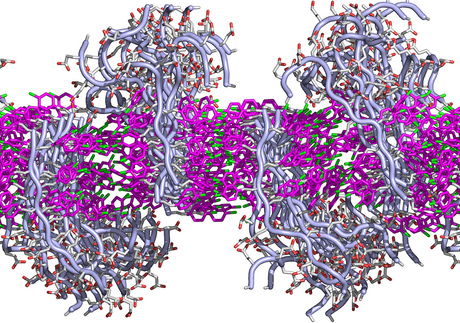A material that mimics cell membranes

US scientists have created a new material that performs like a cell membrane found in nature. Referred to as a lipid-like peptoid, the material can assemble itself into an extremely thin sheet that can withstand being submerged in a variety of liquids and can even repair itself after damage.
Cell membranes are made from thin sheets of fatty molecules called lipids. They are at least 10 times thinner than an iridescent soap bubble and yet allow cells to collectively form organisms as diverse as bacteria, trees and people. They are also very selective about what they let pass through, using tiny embedded proteins as gatekeepers. Membranes repair dings to their structure automatically and change thickness to pass signals from the outside environment to the cell’s interior.
Membrane properties such as gatekeeping could be useful for making filters or signalling to make sensors. For example, mimicking a cell membrane’s gatekeeping could result in water purifying membranes that don’t require a lot of pressure or energy to push the water through. With this in mind, researchers have been investigating synthetic molecules called peptoids, which are cheap, versatile, customisable and similar to natural proteins — including those that embed themselves in cell membranes.
Scientists at the US Department of Energy’s Pacific Northwest National Laboratory (PNNL), led by chemist Chun-Long Chen, decided to see if they could design peptoids to make them more lipid-like. They designed peptoids in which each base peptoid was a long molecule with one water-loving end and one fat-loving end — just like lipid molecules. They then chose chemical features that they hoped would encourage the individual molecules to pack together.
The team found that after putting the lipid-like peptoids into a liquid solution, the molecules spontaneously crystallised and formed what the scientists call nanomembranes — straight-edged sheets as thin as cell membranes — floating in the beaker. These nanomembranes maintained their structure in water or alcohol, at different temperatures, in solutions with high or low pH or high concentrations of salts.
To test whether the synthetic membranes had the signalling ability of cell membranes, the researchers added a touch of salt, which is involved in the last step in many signalling sequences and causes real cell membranes to thicken up. The more salt the researchers added, the thicker the nanomembranes became, reaching about 125% of their original thickness in the range of salt concentrations they tested.
Real membranes also hold proteins that have specific functions, such as ones that only let water through. The group tested the ability of peptoids to do so by introducing a variety of side chains — small molecules of different shapes, sizes and chemical natures attached to the longer lipid-like peptoids. In each of 10 different designs, the peptoids assembled into the nanomembranes with the core structure remaining intact. The team could also build a carbohydrate into nanomembranes, showing the material can be designed to have versatile functions.
Finally, the team tested the nanomembranes to see if they could repair themselves, a useful feature for membranes that could get scratched during use. After cutting slits in a membrane, they added more of the lipid-like peptoid. Viewed under a microscope over the course of a few hours, the scratches filled up with more peptoid and the nanomembrane became complete again.
The study results, published in the journal Nature Communications, show that the researchers are on the right path to making synthetic cell membrane-like materials. The next step, Chen said, is to build biomimetic membranes by incorporating natural membrane proteins or other synthetic water channels such as carbon nanotubes into these sheet matrices. The team is also looking into ways to make the peptoid membranes conductive for energy uses.
“Researchers are trying to make biomimetic membranes that are stable and have certain desired properties of cell membranes,” said Chen. “We believe these materials have potential in water filters, sensors, drug delivery and especially fuel cells or other energy applications.”
Chewing gum can shed microplastics into saliva, study finds
Most of the microplastics detached from gum within the first two minutes of chewing, with the act...
Widespread applications of shake flask off-gas analysis across biotechnology
Despite the emergence of more sophisticated bioreactor systems, shake flasks continue to play a...
Scientists may finally know what makes Mars red
The water-rich iron mineral ferrihydrite may be the main culprit behind Mars's reddish dust,...




